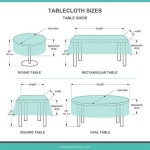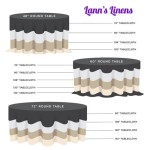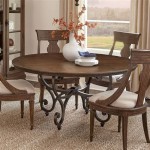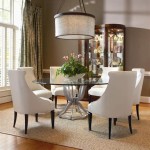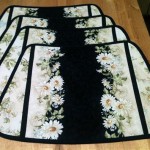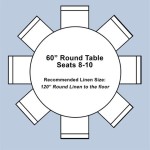Diameter of a Round Table That Seats 8 Seaters in Europe
Determining the optimal diameter for a round table designed to comfortably seat eight individuals in a European context requires careful consideration. Several factors influence the ideal size, including the average personal space preferences in Europe, the presence of armrests on chairs, the thickness of the tabletop, and the intended function of the table. An undersized table will result in crowding and discomfort, while an oversized table can be impractical for the space it occupies. Therefore, a balance must be struck to ensure both functionality and aesthetic appeal.
This article will delve into the specific dimensions required for a round table to comfortably accommodate eight people in Europe. It will consider various aspects of table design and regional preferences to provide a comprehensive understanding of the topic. The aim is to provide practical guidance for selecting or designing a round table that meets both practical needs and aesthetic considerations within a European setting.
Understanding European Space Preferences
Personal space, also known as proxemics, varies across cultures. In European countries, personal space preferences tend to be more defined compared to some other regions of the world. Generally, Europeans value a moderate amount of personal space when interacting with others, and this extends to dining settings. This preference directly impacts the ideal diameter of a round table. A table that is too small forces individuals to encroach upon each other's personal space, leading to discomfort and a less enjoyable dining experience.
To accommodate these preferences, a minimum allowance of space per person is crucial. A comfortable seating arrangement for dining typically requires approximately 60 centimeters (24 inches) of shoulder width per person. This measurement represents the space needed for an individual to move their arms freely and comfortably without bumping into their neighbors. Therefore, calculating the minimum circumference of the table required for eight people starts with this base measurement.
Multiplying the per-person space requirement by the number of people (60 cm x 8 = 480 cm) provides the required circumference. Using the formula relating circumference (C) and diameter (D), where C = πD, we can solve for the diameter. This gives us D = C/π, or D = 480 cm / π (approximately 3.14159). The resulting ideal minimum diameter based on these calculations is roughly 152.79 cm, or approximately 1.53 meters.
However, this calculation represents the absolute minimum. To ensure ample elbow room and comfortable dining, a larger diameter is often preferred. Many designers and furniture manufacturers recommend adding a buffer to these calculations. This buffer accounts for potential variations in chair sizes, the presence of serving dishes in the center of the table, and the general desire for a more relaxed and spacious setting.
Therefore, while a 1.53-meter table could technically seat eight, a diameter closer to 1.8 meters or more is highly recommended for optimal comfort in a European context. This larger diameter provides sufficient space for individual diners and accommodates the practicalities of sharing food and beverages during a meal. Additionally, such a size allows for the inclusion of decorative elements in the center of the table, without causing overcrowding.
Impact of Chair Size and Design
The size and design of the chairs intended for use with the round table significantly affect the overall space requirements. Chairs with armrests, for example, require more lateral space than chairs without armrests. This increased width must be factored into the diameter calculation to prevent overcrowding and ensure comfortable seating.
Standard dining chairs without armrests typically have a width of around 45 to 50 centimeters (18 to 20 inches). However, chairs with armrests can easily exceed 60 centimeters (24 inches) in width. If the chairs intended for use with the round table feature armrests, the per-person space allocation must be adjusted accordingly. Failure to do so will result in individuals being unable to comfortably seat themselves at the table.
Beyond width, the depth of the chair also impacts the overall footprint. Chairs with deeper seats or those that recline require more space behind the table to allow for easy movement and access. This is especially important in smaller dining rooms where space is at a premium. The depth of the chair should be considered when planning the layout of the dining area, ensuring that there is sufficient clearance between the table and any surrounding walls or furniture.
Furthermore, the style and design of the chairs can influence the overall aesthetic of the dining area. Sleek, modern chairs with minimalist designs often require less space than more ornate or traditional chairs. The choice of chair style should complement the design of the round table and the overall décor of the room. Careful consideration of these factors will contribute to a cohesive and visually appealing dining space.
Taking into account chairs with armrests potentially adding several centimeters to the overall seating space, the buffer initially mentioned must be increased. For example, if all eight chairs had armrests adding an extra 5 cm each, that would require an additional 40 cm in circumference, translating to an increase in diameter based on the same C = πD formula. The ideal minimum diameter would then be significantly more than the initial 1.53 meters.
Considering Tabletop Thickness and Material
The thickness of the tabletop, along with the material it is made from, also influences the functionality and aesthetic of the round table. A thicker tabletop generally provides greater stability and durability, but it can also reduce the amount of legroom available for diners. Conversely, a thinner tabletop may be less stable and prone to damage, but it offers more legroom. The optimal thickness depends on the material used and the intended use of the table.
Solid wood tabletops, for example, are often thicker than those made from engineered wood or glass. A solid wood tabletop may range from 2.5 to 5 centimeters (1 to 2 inches) in thickness, while engineered wood tabletops may be thinner, typically around 1.5 to 2.5 centimeters. Glass tabletops can vary significantly in thickness, depending on the type of glass used and the size of the table.
The material of the tabletop also affects its overall weight and stability. Solid wood tabletops are heavier than those made from engineered wood or glass, which can provide greater stability, especially for larger tables. However, the added weight can also make the table more difficult to move. The choice of material should be based on a balance between stability, durability, and ease of handling.
In addition to thickness and material, the edge profile of the tabletop is another important consideration. A rounded edge profile is generally safer and more comfortable than a sharp edge, as it reduces the risk of injury from accidental bumps. A beveled edge can add a touch of elegance to the table, while a straight edge provides a more modern and minimalist look. The edge profile should complement the overall design of the table and the décor of the dining room.
The choice of tabletop material in the European market often reflects local traditions and design preferences. For example, solid oak tabletops are popular in Scandinavian countries, while marble tabletops are often seen in Italian dining rooms. These regional preferences should be taken into account when selecting or designing a round table for a European setting. In conclusion, the thickness and material of the tabletop are important factors to consider when determining the overall dimensions and functionality of a round table for eight people.

8 Seat Round Foldable Mobile School Canteen Table Dining Room Furniture Made In China Com

European Royal Style Golden Wood Marble Round Dining Table Made In China Com

8 10 12 14 Seater Large Round Hoop Base Dining Table Bespoke Chunky 44mm Top

Brewster 6 8 Seat Black Dining Table And Six Madison Chairs

Titan Round Table 2 2m With 8 Deluxe Banana Chairs

Titan 1 8m Round Table With Monaco Chair Outdoor Dining Set

Set Of Sia 6 8 Seat Black Dining Table And Six Sworth Chairs

Dorchester 1 8m Round Teak Garden Dining Table 8 Seater Field Hawken

Brewster Black Dining Table My Furniture

Oet European Standard Foldable Round Dining Table Kitchen 78cm Rt78 Solid Wood 2 Seater
Related Posts

